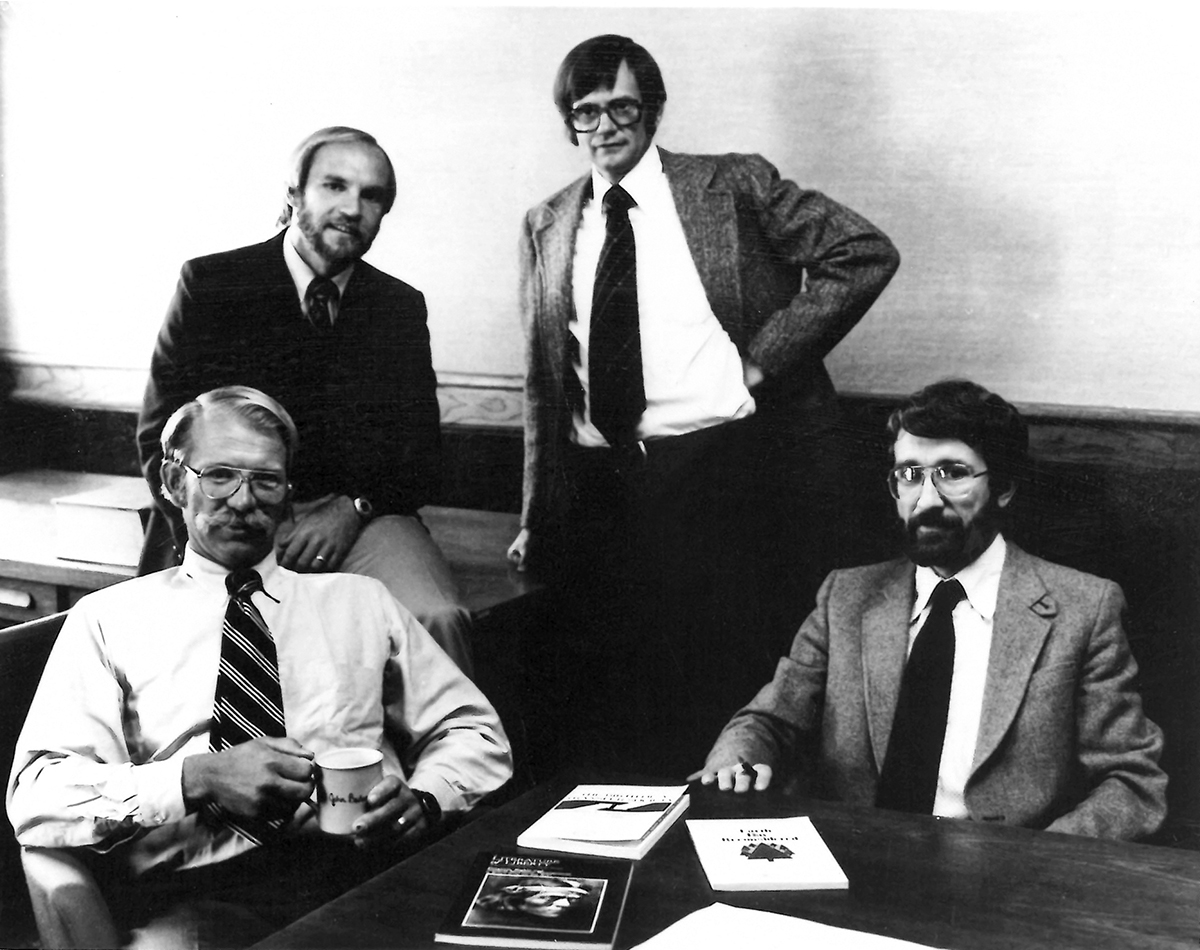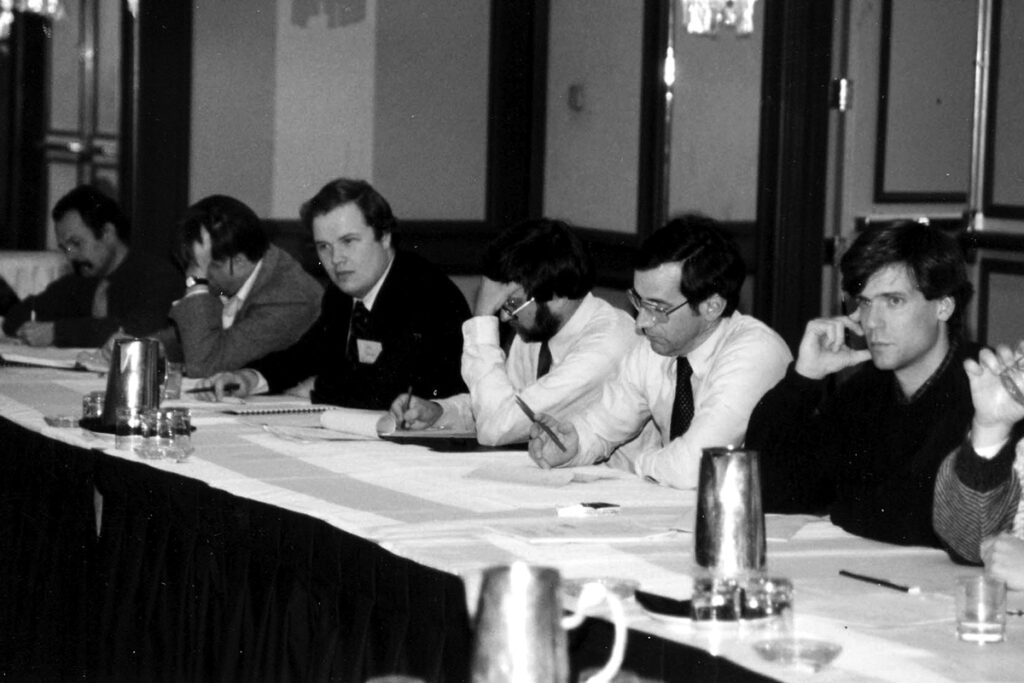Modern practitioners of free market environmentalism trace their origins to Bozeman, Montana, where a few scholars gathered in the early 1970s and began publishing papers and books advocating their approach to solving environmental problems. Richard Stroup and John Baden first outlined several basic principles of free market environmentalism in “Externality, Property Rights, and the Management of our National Forests,” an article published in the reputable Journal of Law and Economics in 1973. The authors identified problems in the management of national forests and recommended several ideas to solve them. By the time Baden and Stroup opened their first think tank, the Center for Political Economy and Natural Resources, at Montana State University in 1978, Terry Anderson and P.J. Hill joined them to complete the foursome most responsible for the genesis of free market environmentalism, a movement that crossed ideological boundaries to combine the environmental ethic of the left with the economic tools of the right.
Their intellectual “toolbox” consisted of principles to guide public policy rather than particular policies themselves, and these principles were based upon classical liberal political philosophy and four approaches to economics: the Austrian School, the Chicago School, property rights theory, and public choice theory. They honed their beliefs and applied them to a variety of environmental problems in dozens of publications during their first decade, and their activities during this period illuminate the mission that occupied the bulk of their professional lives. Not to be confused with the short-lived Sagebrush Rebellion and Wise Use movement, the work of these scholars percolated under the radar for years and continues today. At the heart of the paradigm lay the audacious claim that the principles undergirding capitalism can be used to remedy the excesses of capitalism to help the environment. This approach turned traditional thinking upside down, and the scholars who advocated it have found policy successes around the world.
Despite this success, the literature on the history of environmentalism has largely ignored free market environmentalism. This is a mistake. Their absence is perplexing given how much they have in common with two scholars widely held in esteem by environmental historians, James C. Scott and Karl Jacoby. Scott described “institutional hegemony” as the attempt by experts and their institutions to replace the practical local knowledge of the citizenry with their superior scientific knowledge to plan society. In contrast to the “myth” underlying this hegemony, Jacoby described a simple, rural citizenry that is capable of “understand[ing] the local ecology” and “stewarding local resources.” The entire free market environmentalism enterprise can be understood as an attempt to alleviate the hegemony described by Scott by empowering Jacoby’s rural citizenry. In this respect, free market environmentalism deserves serious attention from environmental historians and modern environmentalists alike because it represents an important and controversial new way of thinking about how humanity strives to understand and find solutions to environmental problems.
The Zeitgeist of Hubris
The failures of Progressive-era conservation in the West motivated the Bozeman foursome. In his 1998 book Seeing Like a State, James C. Scott offered two reasons that explain why scientific management by centralized experts in the 20th century often had environmentally tragic local results. First, the visionary intellectuals and planners of the time “were guilty of hubris,” Scott notes, “forgetting that they were mortals and acting as if they were gods.” Second, “their actions, far from being cynical grabs for power and wealth, were animated by a genuine desire to improve the human condition.” But this was “a desire with a fatal flaw,” according to Scott—despite good intentions, such schemes too often failed their intended beneficiaries.
The group’s early research revealed several lessons that demonstrated the problems with centralized control of environmental and natural resources: First, the incentives driving government officials were not always aligned with the public interest, and second, the good intentions embodied in Progressive institutions were often not sufficient to protect the environment.
Scholars of free market environmentalism could not have said it better. One of their intellectual heroes, Friedrich Hayek, articulated a similar sentiment when he contrasted the “individualism” of classical liberal philosophy with the collectivist ideologies he witnessed in Europe during the 1930s and 1940s: “Individualism,” Hayek wrote, is “an attitude of humility before the social process and of tolerance toward other opinions and is the exact opposite of that intellectual hubris which is at the root of the demand for comprehensive direction of the social process.” Though following different ideological traditions, the foursome in Bozeman shared Scott’s assessment that a similar form of hubris permeated Progressive-era environmental policies.
The group’s early research revealed several lessons that demonstrated the problems with centralized control of environmental and natural resources: First, the incentives driving government officials were not always aligned with the public interest, and second, the good intentions embodied in Progressive institutions were often not sufficient to protect the environment.
This was especially evident when it came to federal land management. Though they accepted some degree of development as inevitable, the Bozeman scholars’ early publications expressed clear disapproval of the status quo that favored extractive industries in public land management decisions. Mandated by the Multiple-Use Sustained-Yield Act of 1960, federal bureaus were supposed to manage public lands to reflect society’s evolving values for recreational activities, viewsheds, and unspoiled ecosystems. Yet, in the eyes of the free market environmentalists, agencies such as the Forest Service, the Bureau of Land Management, and the Bureau of Reclamation often failed to reflect the burgeoning environmental ethic. Instead, extractive industries such as mining and logging appeared to have “captured” the agencies, dominating agency decision-making processes and resulting in policies favorable to extractive industries. The scholars’ research led them to become “increasingly convinced that both the environmental and the economic costs of bureaucratic management of natural resources are excessively and unnecessarily high,” as Baden and Stroup put it in one publication.
Mainstream historical interpretation corroborates their interpretation. Historian Samuel Hays first noted that shortly after the creation of the federal land bureaus, business interests “exerted their power over the new agencies” and shaped “the character of development in a manner contrary to the aims of Conservationists.” This was precisely what the Bozeman scholars meant when they expressed concern that the federal land agencies had been “captured” by extractive industries.
Environmental historian Donald Worster provided a further example when he condemned the Bureau of Reclamation. In 1986, Worster concluded that federal bureaucracies in the West “tend[ed] to impose their outlook and their demands on nature, as they do on the individual and the small human community, and they do so with great destructiveness.” Nancy Langston examined the Forest Service in the Blue Mountains of eastern Washington and Oregon and reached a similar conclusion in Forest Dreams, Forest Nightmares: The Paradox of Old Growth in the Inland West. Though generally well meaning, scientific management of the forests was an ecological disaster, she argued. The case studies by Worster and Langston, motivated by different ideologies than the Bozeman scholars, nonetheless corroborate the predominant theme running through the free market environmentalism publications during their first decade: that the nation needed new land management policies because Progressive-era conservation was not caring for the environment as well as it should.
Contributors to free market environmentalism scholarship express this sentiment in nearly all of their publications during these early years. In “Externality,” Stroup and Baden argued that management decisions often reflect the effectiveness of self-interested lobbying groups to get what they want, rather than an impartial assessment by public servants of myriad public demands. Subsequently, they concluded that both the “public” and the environment may lose out to special interests under bureaucratic management. Published eight years later, the title of the first comprehensive free market environmentalism book, Bureaucracy vs. Environment: The Environmental Cost of Bureaucratic Governance, displayed the centrality of this sentiment to the movement at this time. The collection of essays elaborated on the means by which extractive industries dominated certain bureaucracies and the undesirable ecological outcomes of these institutional arrangements. One representative paper noted that environmentalists attempting to inculcate “new social, cultural, and political values” into the Bureau of Reclamation were repeatedly thwarted by “powerful governmental bureaucracies, pork barrel Congressional committees, and [economic] interests.” In the concluding essay, economist M. Bruce Johnson, reflecting the main theme of the book, lamented, “As well-intentioned as it may have been, the transfer of resource control from private ownership and markets to public ownership and governmental bureaucratic control has not been the panacea some expected.”
Economics to the Rescue
Having thus diagnosed the problems, the Bozeman scholars drew on several rich intellectual traditions to create policies they believed would solve the problems produced by Progressive conservation. Their political philosophies significantly informed the development of their policies and are critical to understanding them as a movement. The founders saw themselves as classical liberals, aiming to uphold, as Anderson and Hill put it, the “integrity of the individual and the right to freedom from coercion.” These continue to be manifest today in the movement’s desire for a limited constitutional government, the rule of law, support for private property rights, and a free-market economy. Two ideas from the classical liberal tradition deserve particular attention for their prevalence to free market environmentalism scholarship, and also because of their similarity to some of the ideas of environmental historians Scott and Jacoby.
The first idea is “spontaneous order,” first articulated by Bernard Mandeville in 1714. Mandeville argued that when individuals are free to pursue the “vice” of self interest to improve their material well being, they end up benefiting society at large by creating a sophisticated social order that nobody could have foreseen or planned. Thus, the right of individuals to engage in voluntary exchange—socially, economically, or otherwise (and without harming anybody)—is critical to healthy, free societies. Advocates of spontaneous order embrace societies formed by bottom-up processes and warn of those imposed upon the people from the top down. In contrast with centralized bureaucracies, the Bozeman scholars believe spontaneously ordered societies are the antidote to institutional hegemony and are likely to be more just, equitable, and environmentally friendly.
The second idea is “legal plunder.” Frédéric Bastiat, a French statesman of the mid-19th century, warned that the law could be perverted and, instead of protecting all people, it could be used to enrich some members of society at the expense of others. He claimed that there were only three ways to organize society: (1) “The few plunder the many,” (2) “Everybody plunders everybody,” or (3) “Nobody plunders anybody.” (In Bastiat’s construction, the “few” referred to a powerful elite that controlled society’s wealth and government.) Endorsing Bastiat’s preference for the latter, free market environmental policies strive to limit the use of state coercion to prevent elite groups—for instance, extractive industries—from trampling individual rights.
To apply these ideals to the environment, free market environmentalists turned to the notion of the “tragedy of the commons,” described in a famous 1968 paper by ecologist Garrett Hardin. Among other things, Hardin identified open range land in the West as a commons—an unowned and open-access resource that, absent regulation by either custom or law, will result in overconsumption and, ultimately, depletion. The Bozeman foursome expanded upon this insight to posit that solving the tragedy of the commons required the creation of new institutions that generated better information for decision makers and incorporated incentives to promote sound stewardship.
To find alternative institutional arrangements, Anderson, Baden, Hill, and Stroup turned to several strains of economic theory: the Chicago School, Austrian School, emerging property rights theory, and the burgeoning subfield of economics known as “public choice.” The Bozeman connection to Chicago was often personal. P.J. Hill earned his Ph.D. in economics at the University of Chicago in 1970, and several notable Chicago economists took interest in free market environmentalism, participating in conferences and contributing to publications. Among other things, the school emphasized the role of positive incentives acting on self-interested individuals, an aspect of human nature that the Bozeman scholars believed contributed to the destruction of the commons but could also play a part in solving the tragedy. On the one hand, government subsidies to extractive industries amounted to an incentive to log and mine more than they otherwise would. These perverse incentives amounted to taxpayer-funded destruction of the environment.
In contrast, the Bozeman scholars asserted that ownership of a resource creates incentives for individuals to consider the long term and conserve. As one contributing author wrote, “Whether it is organized around a profit seeking or non-profit undertaking, there are incentives for the owner to preserve the resource… [because they] capture the full capital value of the resource.” To promote salutary incentives, the scholars contemplated the merits of various alternative ownership schemes—nonprofit, communal, private—as well as considered creative new institutional arrangements that maintained government ownership of resources. Tribal ownership of elephant herds in Zimbabwe to curb poaching is just one example of the implementation of their work in this area.
As Scott noted, bureaucracies often suffered from the inability to collect the dispersed information needed to carry out their plans successfully. A strikingly similar argument was made by scholars in the Austrian School of economics. Friedrich Hayek, in his 1945 article, “The Use of Knowledge in Society,” articulated an idea that won him a Nobel Prize in 1974: Economic information is time and place specific, thus centrally planning an entire economy was impossible to do well. The Bozeman scholars applied this to the environment, noting that ecological knowledge varies widely, constantly changes, and is imperfectly understood. To be effective, they argued, policies must harness the creative energies of dispersed parties that hold unique knowledge of particular ecosystems and empower them to act. Nonprofit environmental groups and local stewards met these criteria. Generating new institutional arrangements that shaped their behavior in an environmentally friendly direction became the next task.
The scholars believed that well-defined and transferable property rights help remedy the tragedy of the commons by producing information and creating positive incentives for individuals to act in environmentally friendly ways. Economists Ronald Coase and Harold Demsetz played critical roles in advancing their field’s understanding of property rights. Coase used examples of grazing and air pollution to illustrate the importance of property rights and the ways in which property law could hold polluters liable for their effects on neighboring property. Demsetz expanded on Coase’s insights, claiming that property rights were not absolute and evolved over time as circumstances changed.
The four economic theories used by the scholars of free market environmentalism represented major theoretical breakthroughs in the understanding of human behavior.
The founders of free market environmentalism applied these insights to the environment, noting that property rights could be defined to create incentives for stewardship, as long as common law and nuisance liability law were similarly enhanced. This would enable environmental resources to become assets for their owners, extending the decision-making calculus to include long-term effects. The extension of property rights to ocean fisheries via individual transferable quotas, also known as catch shares—a policy that has since been adopted by various countries around the world—provides one example. The Bozeman scholars also held that, as long as such rights could be transferred, the price system would provide information about their worth, thus approximating the subjective values of society. Therefore, they often sought to make non-transferable property rights, such as grazing rights on public lands, transferable so that environmental groups may purchase and retire them. Finally, the scholars believed that property rights could be defined in a way that circumscribed the behavior of the title holder, as with conservation easements, for example.
The final intellectual influence on the Bozeman scholars was public choice theory, which scrutinized “government failure,” an analog to market failure that applies when the political process rather than the market process produces negative externalities. The pioneers of public choice, James Buchanan and Gordon Tullock, posited the unthinkable in 1962: Perhaps those in the public sphere—such as politicians and bureaucrats—are motivated by self-interest just like most other people. This was a radical proposal at the time, as conventional wisdom treated bureaucracies as if they were benign institutions that served the public good with objectivity and omniscience.
All of the major intellectual contributions to the free market environmentalism paradigm were new or resurgent in the 1970s. Further, the four economic theories used by the scholars of free market environmentalism represented major theoretical breakthroughs in the understanding of human behavior: The pioneers of each won Nobel Prizes in economics between 1974 and 1991. By combining these disparate intellectual strands into an internally consistent theory, the Bozeman scholars broke new ground. Particular economic principles had been applied to the environment, but these applications had been piecemeal. Never had the principles driving market forces been applied so thoroughly to the task of analyzing and solving environmental problems.
Tree-Top Activists
In the fall of 1979, two dozen economists descended upon Bozeman to attend the first conference hosted by the nascent free market environmentalism movement. The topic was “The Environmental Cost of Bureaucratic Governance.” This seminal event—a sort of Earth Day for economists—inaugurated a new paradigm that represented a radical break from traditional environmental economists. It was the first of 17 colloquia to be held over the next three years, and one of hundreds of such events that the Bozeman scholars would host during the next four decades.
Guests at their conferences included academics, influential journalists, businesspeople, policy specialists, government bureaucrats, federal judges, and environmentalists. Academics comprised most of the 28 participants at the first conference, but representatives from the Wilderness Society, Environmental Defense Fund, and Western Timber Association also attended. Representatives from national public policy institutes such as the Heritage Foundation and Center for the Study of Public Choice joined as well, demonstrating the group’s remarkable networking prowess. The main focus at these conferences was to read and discuss free market environmentalism scholarship and related work. In addition to seminars, the Bozeman scholars sought to publish as much as possible, wherever possible. This included academic journals, books, policy reports, and opinion pieces in national and local newspapers. Their approach was purposefully long term, one that Baden claims “was designed to help my grandchildren.” They primarily targeted influential elites, and they hoped their influence would percolate throughout society—a sort of trickle-down environmentalism.
Though they eventually coalesced into a single movement, the backgrounds of the primary foursome did not portend the genesis of a “new” brand of environmentalism. Baden studied anthropology, Anderson and Hill economic history, and only Stroup’s dissertation, “The Economics of Air Pollution Control,” was an explicit study of environmental issues. Yet despite their disparate prior interests, these individuals advanced what became their common goal of free market environmentalism. First, the Center of Political Economy and Natural Resources (CPENR) was established in 1978 in partnership with Montana State University. The center’s mission was “to provide an institutional setting that fosters the study of political economy and natural resource issues” in order to “examine how a property rights and market approach can be applied to critical issues of resource policy.” Its closure a few years later facilitated the creation in 1980 of PERC, which took up CPENR’s mission and activities but was purposefully independent of the university.
In pursuing seminars, the Bozeman scholars acted upon their belief in the impact that powerful ideas can exert on public policy. The seminars were formulaic: Invite about 20 people, send out readings to participants before the seminar, gather for a few days to discuss the readings, and enjoy meals, leisure activities, and polite conversation between sessions. The first goal was that people would read, think about, and discuss ideas. The second goal was that good ideas would emerge from the process, and participants would gradually disseminate them throughout society. Participants need not agree with each other, but they had to follow the protocol of civil discourse. By encouraging the open exchange of ideas, the scholars aspired to generate a better understanding of the environmental issues facing society.
The scholars also warned that trusting a powerful centralized government to be the primary steward of the environment was a dangerous pursuit subject to the whims of politicians and bureaucrats.
Over the years, the Bozeman group created a stable base of operations from which the free market environmentalism movement could expand, and they successfully leveraged their comparative advantage—the natural splendor of Montana—to host hundreds of conferences, which at the time was their primary outreach mechanism. Their ability to associate with elite intellectuals, including five winners of the Nobel Prize in economics and two future secretaries of the U.S. Department of the Interior, is a testament to the respect others had for the quality of their scholarship. Targeting journalists proved fruitful as well; many subsequently invited the Bozeman scholars to pen editorials or wrote their own articles on the movement’s ideas. In sum, their long-term approach to activism worked. Policymakers in the United States and around the world now recognize free market environmentalism as a viable tool for solving environmental problems.
Contention or Comprehension?
Now, four decades later, as concern about environmental issues continues to grow, the movement that Anderson, Baden, Hill, and Stroup built now receives widespread national and international attention. The group from Bozeman identified environmental problems generated by markets and those endemic to government management and then developed a broad set of principles necessary to overcome them. Their paradigm challenged the widely held perception that environmental problems were unique and could only be solved through government intervention to mitigate market failure. This flawed belief, they posited, too often resulted in a one-size-fits-all approach to environmental legislation that neglected important differences among diverse ecosystems and ignored local knowledge. The scholars also warned that trusting a powerful centralized government to be the primary steward of the environment was a dangerous pursuit subject to the whims of politicians and bureaucrats. To ameliorate these problems, free market environmentalists strove to align individuals’ self-interest with society’s environmental interests, thus harmonizing environmental goals with responsible economic growth and an appreciation for the ideals of a free society.
Anderson, Baden, Hill, and Stroup deserve recognition as the originators of a comprehensive new approach to environmental issues. The idea of using the principles powering capitalism to remedy the excesses of capitalism had not previously been advocated in such a sustained manner. But after 40 years, free market environmentalism has certainly arrived. Its influence on domestic environmental policy already extends deep into federal and state policymaking circles, and several nations, such as South Africa, have turned to PERC for answers to their environmental problems. While some of their ideas may provoke debate and disagreement, their achievement lies in expanding the set of possible solutions from which environmentalists and environmental policymakers can choose. For too long, many responded reflexively to free market environmentalism with contention. Now, it is time for measured comprehension.
This essay is adapted from “The Economists in the Garden: The Historical Roots of Free Market Environmentalism,” a paper published in 2007 at the Department of History and Philosophy at Montana State University.







